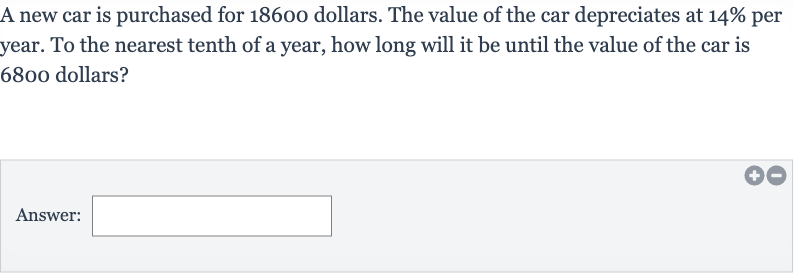Full solution
Q. A new car is purchased for dollars. The value of the car depreciates at per year. To the nearest tenth of a year, how long will it be until the value of the car is dollars?Answer:
- Identify type of depreciation: Determine the type of depreciation.The car depreciates at a constant percentage each year.This is an example of exponential decay.
- Find initial value, rate, final value: Identify the initial value , the rate of depreciation , and the final value .Initial value = Rate of depreciation = per year or as a decimalFinal value =
- Set up exponential decay formula: Set up the exponential decay formula.The formula for exponential decay is , where is the value after time , is the initial value, and is the rate of decay.
- Plug in known values: Plug in the known values into the exponential decay formula.
- Solve for t: Solve for t.First, divide both sides by to isolate the exponential part of the equation.
- Take natural logarithm: Take the natural logarithm of both sides to solve for .
- Use logarithm property: Use the property of logarithms that .
- Divide by : Divide both sides by to solve for .
- Calculate value of t: Calculate the value of t using a calculator.
- Round to nearest tenth: Round the answer to the nearest tenth of a year. years
More problems from Exponential growth and decay: word problems
QuestionGet tutor help
QuestionGet tutor help
QuestionGet tutor help
QuestionGet tutor help
QuestionGet tutor help
QuestionGet tutor help
QuestionGet tutor help
QuestionGet tutor help
QuestionGet tutor help

